
Fritillaria meleagris is a Eurasian species of flowering plant in the lily family Liliaceae. Its common names include snake's head fritillary, snake's head, chess flower, frog-cup, guinea-hen flower, guinea flower, leper lily, Lazarus bell, chequered lily, chequered daffodil, drooping tulip or, in the British Isles, simply fritillary. The plant is a bulbous perennial native to the flood river plains of Europe where it grows in abundance.

The parti-coloured bat or rearmouse is a species of vesper bat that lives in temperate Eurasia, from Western and Southern Europe, eastwards over the Caucasus and Iran into Mongolia, north-east China, Korea, Afghanistan and northern Pakistan.

Mu Sigma Upsilon Sorority, Incorporated (ΜΣΥ) is a multicultural intercollegiate sorority founded on November 21, 1981 at Rutgers University, New Brunswick and is recognized as the First Multicultural Sorority in the Nation. It is a non-profit Greek-lettered organization for college-educated women that promotes the goals of Academic Achievement, Unity Amongst All Women, and University and Community Service. Mu Sigma Upsilon is a multicultural-based sorority in the United States and a founding member of the National Multicultural Greek Council.

Phi Sigma Alpha (ΦΣΑ), commonly known as La Sigma, is a Puerto Rican fraternity originally established as the Sigma Delta Alpha Fraternity on October 22, 1928, at the University of Puerto Rico by 12 students and a professor. Phi Sigma Alpha can trace its roots back to 1898 to the Union Hispano Americana, as well as to the first ever Greek letter Hispanic-oriented fraternity, Sigma Iota, established in 1912. By 1998 there were over 4,376 members.

Suillellus luridus, commonly known as the lurid bolete, is a fungus of the family Boletaceae, found in calcareous broadleaved woodlands in Europe. Fruit bodies appear in summer and autumn and may be locally abundant. It is a firm bolete with an olive-brown cap up to 20 cm (8 in) in diameter, with small orange or red pores on the underside. The stout ochre stem reaches 8–14 cm (3–6 in) high and 1–3 cm (0.4–1.2 in) wide, and is patterned with a red network. Like several other red-pored boletes, it stains blue when bruised or cut.
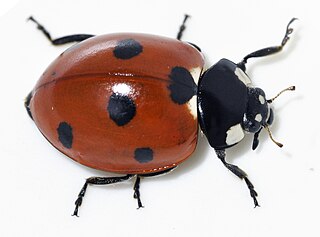
Coccinellidae is a widespread family of small beetles. They are commonly known as ladybugs in North America and ladybirds in Great Britain. Entomologists prefer the names ladybird beetles or lady beetles to avoid confusion with true bugs. Many of the species have conspicuous aposematic colours and patterns, such as red with black spots, that warn potential predators that they are distasteful.
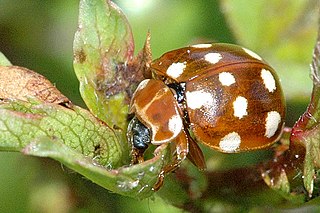
Calvia quatuordecimguttata, the cream-spot ladybird, is a species of ladybird in the family Coccinellidae. Its distribution is holarctic, it being found in Europe and through the East Palearctic to Japan. It is introduced to North America. This ladybird is generally 4 to 5 millimetres in length and varies in appearance depending on the geographical location. It usually lives in hedgerows and deciduous trees.

Philorhizus is a genus of beetles in the family Carabidae, containing the following species:
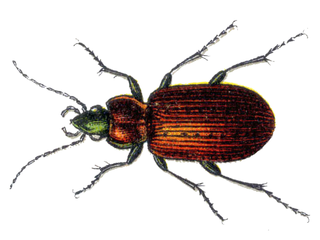
Agonum impressum is a species of ground beetles in the subfamily Platyninae.

Agonum versutum is a species of ground beetle in the Platyninae subfamily that is found in most of Europe.
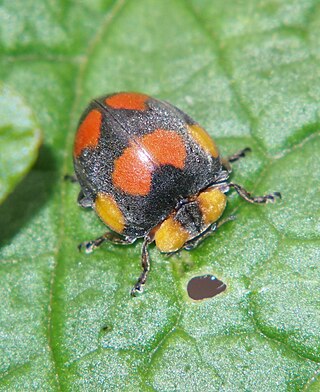
Papuaepilachna guttatopustulata, the large leaf-eating ladybird, is a species of ladybird, formerly in the genus Henosepilachna endemic to parts of Australasia, specifically New South Wales, Queensland, the Bismarck Archipelago, New Guinea, New Hebrides and Solomon Islands.
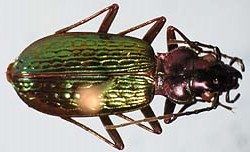
Nebria fulgida is a species of ground beetle in the Nebriinae subfamily that can be found in Russian autonomous republics such as Khamar-Daban, Buryat Republic, and East Sayan. Females have either reddish or greenish coloured elytron and are 11 millimetres (0.43 in) in length.
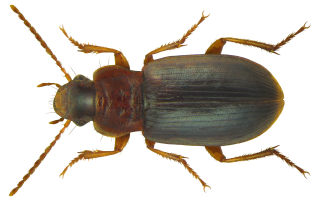
Ophonus rufibarbis is a species of ground beetle that can be found everywhere in Europe and the Near East.
Philorhizus vectensis is a species of brown coloured ground beetle in the Lebiinae subfamily that can be found in British Isles, France, Portugal, and Spain.
Cicindela togata, Laurentian tiger beetle is a species of tiger beetle in the Cicindelinae subfamily that can be found in Minnesota, Manitoba, and Ontario. The species have green coloured elytron and is 13–15 millimetres (0.51–0.59 in) long. It can be found in gravel and sand as well as coniferous forests where it preys on other insect species. When it comes to hunting, adults are either wait for their prey in an ambush or chase it. It larvae usually digs burrows in which they wait for their victim to come by. Once an unsuspected arthropod is in site, it opens it jaws and eats it.
Dicerca tenebrica, the flatheaded wood borer or flatheaded poplar borer, is a brassy to black coloured beetle from Chrysochroinae subfamily which can be found in Canada and both Southern and Northeastern United States. The species was first described by William Kirby in 1837.
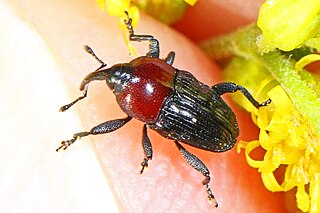
Madarellus undulatus is a species of weevils belonging to the Baridinae subfamily. It is 2.8–4.5 millimetres (0.11–0.18 in) long and have brown coloured head and black or sometimes reddish body. The prothorax is glossy and somewhat punctate with striate elytron. M. undulatus can be found in both Canada and in the United States. Larvae feed on poison ivy and Parthenocissus quinquefolia.

Dyschirius thoracicus is a species of ground beetle in the subfamily Scaritinae. It was described by P. Rossi in 1790.

Philorhizus melanocephalus is a species of ground beetle in the family Carabidae. It is found in North America, Europe, temperate Asia, and Africa.















